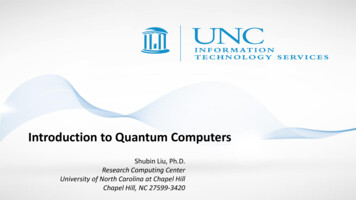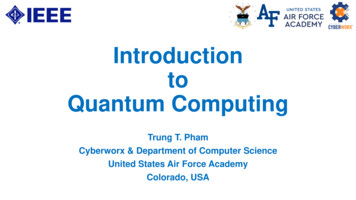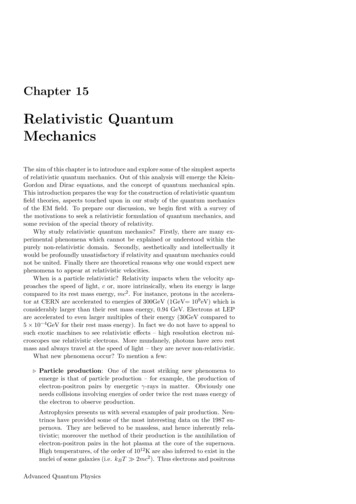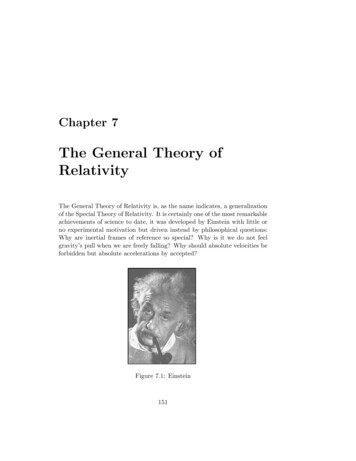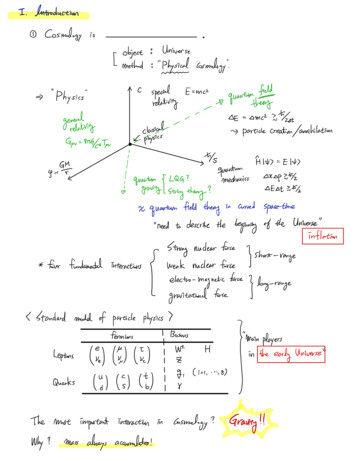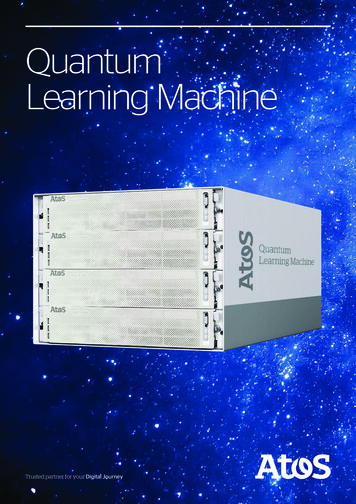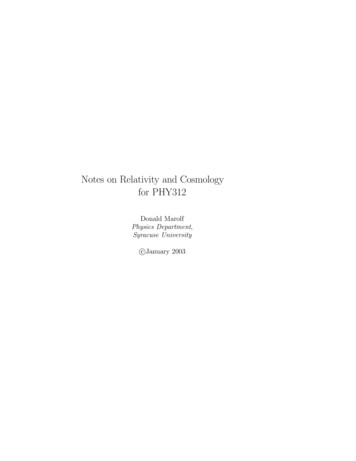
Transcription
Introduction toSpecial Relativity, Quantum Mechanics and Nuclear PhysicsforNuclear EngineersAlex F BielajewThe University of MichiganDepartment of Nuclear Engineering and Radiological Sciences2927 Cooley Building (North Campus)2355 Bonisteel BoulevardAnn Arbor, Michigan 48109-2104U. S. A.Tel: 734 764 6364Fax: 734 763 4540email: bielajew@umich.educ 2010–12 Alex F BielajewDecember 15, 2014
2
PrefaceThis book arises from a series of hand-written notes I am continually revising in support oftwo courses I teach, each a three-credit (42 hour) junior-level course, NERS311 and NERS312: Elements of Nuclear Engineering and Radiological Sciences I and II at the Departmentof Nuclear Engineering and Radiological Sciences at the University of Michigan.More apt titles for these courses would be NERS311: Modern Physics and Quantum Mechanics and NERS312: Nuclear Physics because there is very little engineering in the coursecontent. Rather, we shall dwell on the sciences that underpin Nuclear Engineering and Radiological Sciences, for it is essential that we understand, in some detail, the nature of thestuff we are engineering. Nuclear materials and the resultant radiation are really some of themost dangerous (and interesting) things in the world, and, in my view at least, understandingthem, at least in some depth, is essential.These two courses assume, and make great use of, the earlier background courses in mathematics and physics. So, if you get stuck on some mathematics or physics concept, pleasedive into your old notes and texts, or ask questions. These things may have seemed tiredand dry when you learned them initially, but these courses will bring them to back to life,with some vigor, and a great deal of power. By their very nature, the consequences ofSpecial Relativity and Quantum Mechanics are counterintuitive. Our understanding of veryfast and/or very small objects is not reinforced by our everyday experiences. Consequently,the understanding of these phenomena falls to mathematical interpretation, that must berefined, to enable deeper understanding. Much like a blind person, whose other senses aresharpened to enable him or her to experience the world, so it is that mathematics becomesmore important. Equations really do speak, if you listen the right way.I would like to thank the students who took my first versions of there courses in the Fall of2005, and Winter of 2006. Your feedback convinced me that I should undertake this writing.Your support was deeply appreciated. To you taking NERS 311 or 312 now, this is verymuch a work-in-progress. There will be spelling and grammatical errors, sloppy English,missing figures, the occasional bad equation, and, once in a while, a logical argument thatdoes not make complete sense. If you find an error or can suggest an improvement, pleasebring it to me. I am most grateful for these. These notes may seem to be under constantrevision. They are, and it is a natural part of their development. Please bear with this. Oni
iithe plus side, they’re free!About Krane’s book, Modern Physics, Second editionThis is a decent text, good value for the money, but not perfect. If it were, these notes wouldnot exist! I hope these notes bring some added value to the material. In several cases, Idisagree with Krane’s approach, and will offer a little more rigor. In a few cases, I’ll disagreewith Krane’s interpretation of, in particular, Quantum Mechanics. This is not to say Krane’sapproach is wrong, because these topics are still being debated by theoretical physicists andnatural philosophers. However, I will try to justify my view of things.Two of the greatest things about Krane’s book are the collection of Questions and Problemsat the back of each Chapter. Good students should make use of these sections to the extentthat your interest, energy and time permit. I will provide more encouragement throughoutthe text.AFB, October 2, 20062008 updateIn 2008, the 311 course was reduced to 3 credits from 4, at the expense of eliminating mostof the Special Relativity material from the lectures. Most of that material is not essentialto obtaining a thorough understanding of Quantum Mechanics and Nuclear Physics. Whatis essential, and what will continue to be taught are the relativistic kinematical relations, aswe shall be learning about photons, that travel at the speed of light, and energetic electronsfrom β-decay, that have velocities close to the speed of light. I’ve elected to leave the ModernPhysics material intact. It’s good science culture, and perhaps an interested student or twowill be motivated to study this topic deeper.2009 updateExtensive revisions to most chapters have been undertaken. I’d like to thank Ms. LindaPark for her excellent and erudite proofreading of the technical and non-technical material.Linda, I am in awe of your attention-to-detail.A brief note on chapter headingsChapter and subchapter headings preceded by a dagger† do not exist in Krane’s book, andare here for supplementary, prerequisite, or co-requisite study. They will be covered on aneed-to basis. Chapter and subchapter headings preceded by an asterisk are generally notcovered in teaching the NERS 311/312 editions of the class.AFB, July 16, 2009
Contents1 Introduction11.1About this book . . . . . . . . . . . . . . . . . . . . . . . . . . . . . . . . . .11.2Modern Physics, Quantum Mechanics and Nuclear Physics . . . . . . . . . .21.3Some History . . . . . . . . . . . . . . . . . . . . . . . . . . . . . . . . . . .101.4Review of Classical Physics. . . . . . . . . . . . . . . . . . . . . . . . . . .13Mechanics . . . . . . . . . . . . . . . . . . . . . . . . . . . . . . . . .131.5Units and Dimensions . . . . . . . . . . . . . . . . . . . . . . . . . . . . . .221.6Significant Figures . . . . . . . . . . . . . . . . . . . . . . . . . . . . . . . .221.7Theory, Experiment, Law. . . . . . . . . . . . . . . . . . . . . . . . . . . .231.8†Basic Error Estimation . . . . . . . . . . . . . . . . . . . . . . . . . . . . .231.4.11.8.1Accounting for Estimated Error for Independent Quantities . . . . . .23Questions . . . . . . . . . . . . . . . . . . . . . . . . . . . . . . . . . . . . .241.10 Problems . . . . . . . . . . . . . . . . . . . . . . . . . . . . . . . . . . . . . .241.11 Supplementary Problems . . . . . . . . . . . . . . . . . . . . . . . . . . . . .241.92 The Special Theory of Relativity272.1 Classical Relativity . . . . . . . . . . . . . . . . . . . . . . . . . . . . . . .272.2 The Michelson-Morley Experiment . . . . . . . . . . . . . . . . . . . . . . .292.3 Einstein’s Postulates . . . . . . . . . . . . . . . . . . . . . . . . . . . . . . .312.4 The Lorentz Transformation . . . . . . . . . . . . . . . . . . . . . . . . . .312.5Relativistic Dynamics . . . . . . . . . . . . . . . . . . . . . . . . . . . . . . .372.6Questions . . . . . . . . . . . . . . . . . . . . . . . . . . . . . . . . . . . . .45iii
ivCONTENTS2.7Problems . . . . . . . . . . . . . . . . . . . . . . . . . . . . . . . . . . . . . .3 The Particlelike Properties of Electromagnetic Radiation45473.1Review of Electromagnetic Waves . . . . . . . . . . . . . . . . . . . . . . . .473.2The Photoelectric Effect . . . . . . . . . . . . . . . . . . . . . . . . . . . . .473.3Blackbody Radiation . . . . . . . . . . . . . . . . . . . . . . . . . . . . . . .483.4The Compton Effect . . . . . . . . . . . . . . . . . . . . . . . . . . . . . . .483.5Other Photon Processes . . . . . . . . . . . . . . . . . . . . . . . . . . . . .483.6What is a Photon? . . . . . . . . . . . . . . . . . . . . . . . . . . . . . . . .484 The Wavelike Properties of Particles494.1De Broglie’s Hypothesis . . . . . . . . . . . . . . . . . . . . . . . . . . . . .494.2Uncertainty Relationships for Classical Waves . . . . . . . . . . . . . . . . .504.3Heisenberg Uncertainty Relationships . . . . . . . . . . . . . . . . . . . . . .504.4Wave Packets . . . . . . . . . . . . . . . . . . . . . . . . . . . . . . . . . . .504.5Probability and Randomness . . . . . . . . . . . . . . . . . . . . . . . . . . .524.6The Probability Amplitude . . . . . . . . . . . . . . . . . . . . . . . . . . . .525 The Schrödinger Equation in 1D535.1Justifying the Schrödinger Equation . . . . . . . . . . . . . . . . . . . . . . .545.2The Schrödinger Recipe . . . . . . . . . . . . . . . . . . . . . . . . . . . . .555.3Probability Densities and Normalization . . . . . . . . . . . . . . . . . . . .555.4Applications of Scattering in 1D . . . . . . . . . . . . . . . . . . . . . . . . .565.4.1Time-Independent Scattering Applications . . . . . . . . . . . . . . .565.5Applications of Time-Independent Bound States . . . . . . . . . . . . . . . .585.6Transitions . . . . . . . . . . . . . . . . . . . . . . . . . . . . . . . . . . . . .595.7†59Time-Dependent Perturbations . . . . . . . . . . . . . . . . . . . . . . . . .5.7.1Fermi’s Golden Rule #2 . . . . . . . . . . . . . . . . . . . . . . . . .595.7.2The Lorentz Distribution . . . . . . . . . . . . . . . . . . . . . . . . .636 The Rutherford-Bohr Model of the Atom65
CONTENTSv6.1Basic Properties of Atoms . . . . . . . . . . . . . . . . . . . . . . . . . . . .656.2The Thomson Model . . . . . . . . . . . . . . . . . . . . . . . . . . . . . . .656.3The Rutherford Nuclear Atom . . . . . . . . . . . . . . . . . . . . . . . . . .656.4Line Spectra . . . . . . . . . . . . . . . . . . . . . . . . . . . . . . . . . . . .656.5The Bohr Model. . . . . . . . . . . . . . . . . . . . . . . . . . . . . . . . .656.6The Franck-Hertz Experiment . . . . . . . . . . . . . . . . . . . . . . . . . .656.7The Correspondence Principle . . . . . . . . . . . . . . . . . . . . . . . . . .656.8Deficiencies of the Bohr Model . . . . . . . . . . . . . . . . . . . . . . . . . .657 The Hydrogen Atom677.0.1Central force, two-body systems in Classical Mechanics . . . . . . . .677.0.2Central force, two-body systems in Quantum Mechanics. . . . . . .687.1The Schrödinger Equation in 3D . . . . . . . . . . . . . . . . . . . . . . . . .687.2The Hydrogenic Atom Wave Functions . . . . . . . . . . . . . . . . . . . . .707.3Radial Probability Densities . . . . . . . . . . . . . . . . . . . . . . . . . . .707.4Angular Momentum and Probability Densities . . . . . . . . . . . . . . . . .707.5Intrinsic Spin . . . . . . . . . . . . . . . . . . . . . . . . . . . . . . . . . . .707.6Energy Level and Spectroscopic Notation . . . . . . . . . . . . . . . . . . . .707.7The Zeeman Effect . . . . . . . . . . . . . . . . . . . . . . . . . . . . . . . .707.8Fine Structure . . . . . . . . . . . . . . . . . . . . . . . . . . . . . . . . . . .708 Many-Electron Atoms718.1The Pauli Exclusion Principle . . . . . . . . . . . . . . . . . . . . . . . . . .718.2Electronic States in Many-Electron Atoms . . . . . . . . . . . . . . . . . . .718.3The Periodic Table . . . . . . . . . . . . . . . . . . . . . . . . . . . . . . . .718.4Properties of the Elements . . . . . . . . . . . . . . . . . . . . . . . . . . . .718.5X-Rays . . . . . . . . . . . . . . . . . . . . . . . . . . . . . . . . . . . . . . .718.6Optical Spectra . . . . . . . . . . . . . . . . . . . . . . . . . . . . . . . . . .718.7Addition of Angular Momenta . . . . . . . . . . . . . . . . . . . . . . . . . .718.8Lasers . . . . . . . . . . . . . . . . . . . . . . . . . . . . . . . . . . . . . . .71
viCONTENTS9 Review of Classical Physics Relevant to Nuclear Physics7310 Nuclear Properties7510.1 The Nuclear Radius . . . . . . . . . . . . . . . . . . . . . . . . . . . . . . . .7810.1.1 Application to spherical charge distributions . . . . . . . . . . . . . .8010.1.2 Nuclear shape data from electron scattering experiments . . . . . . .8810.1.3 Nuclear size from spectroscopy measurements . . . . . . . . . . . . .8910.2 Mass and Abundance of Nuclei . . . . . . . . . . . . . . . . . . . . . . . . .9410.3 Nuclear Binding Energy . . . . . . . . . . . . . . . . . . . . . . . . . . . . .9510.4 Angular Momentum and Parity . . . . . . . . . . . . . . . . . . . . . . . . .9910.5 Nuclear Magnetic and Electric Moments . . . . . . . . . . . . . . . . . . . . 10010.5.1 Magnetic Dipole Moments of Nucleons . . . . . . . . . . . . . . . . . 10010.5.2 Quadrupole Moments of Nuclei . . . . . . . . . . . . . . . . . . . . . 10211 The Force Between Nucleons11911.1 The Deuteron . . . . . . . . . . . . . . . . . . . . . . . . . . . . . . . . . . . 12311.2 Nucleon-nucleon scattering . . . . . . . . . . . . . . . . . . . . . . . . . . . . 12711.3 Proton-proton and neutron-neutron interactions . . . . . . . . . . . . . . . . 12711.4 Properties of the nuclear force . . . . . . . . . . . . . . . . . . . . . . . . . . 12811.5 The exchange force model . . . . . . . . . . . . . . . . . . . . . . . . . . . . 12812 Nuclear Models13112.1 The Shell Model . . . . . . . . . . . . . . . . . . . . . . . . . . . . . . . . . . 13412.2 Even-Z, even-N Nuclei and Collective Structure . . . . . . . . . . . . . . . . 14912.2.1 The Liquid Drop Model of the Nucleus . . . . . . . . . . . . . . . . . 15013 Radioactive Decay15913.1 The Radioactive Decay Law . . . . . . . . . . . . . . . . . . . . . . . . . . . 15913.2 Quantum Theory of Radioactive Decay . . . . . . . . . . . . . . . . . . . . . 16313.3 Production and Decay of Radioactivity . . . . . . . . . . . . . . . . . . . . . 17413.4 Growth of Daughter Activities . . . . . . . . . . . . . . . . . . . . . . . . . . 178
CONTENTSvii13.5 Types of Decays . . . . . . . . . . . . . . . . . . . . . . . . . . . . . . . . . . 18113.6 Natural Radioactivity . . . . . . . . . . . . . . . . . . . . . . . . . . . . . . . 18413.7 Radioactive Dating . . . . . . . . . . . . . . . . . . . . . . . . . . . . . . . . 18413.8 Units for Measuring Radiation . . . . . . . . . . . . . . . . . . . . . . . . . . 18514 α Decay18914.1 Why α Decay Occurs . . . . . . . . . . . . . . . . . . . . . . . . . . . . . . . 18914.2 Basic α Decay Processes . . . . . . . . . . . . . . . . . . . . . . . . . . . . . 18914.3 α Decay Systematics . . . . . . . . . . . . . . . . . . . . . . . . . . . . . . . 19114.4 Theory of α Emission . . . . . . . . . . . . . . . . . . . . . . . . . . . . . . . 19214.4.1 Comparison with Measurements . . . . . . . . . . . . . . . . . . . . . 19714.5 Angular momentum and parity in α decay . . . . . . . . . . . . . . . . . . . 19814.6 α-decay spectroscopy . . . . . . . . . . . . . . . . . . . . . . . . . . . . . . . 20015 β Decay20115.1 Energy release in β decay . . . . . . . . . . . . . . . . . . . . . . . . . . . . 20315.2 Fermi’s theory of β decay. . . . . . . . . . . . . . . . . . . . . . . . . . . . 20715.3 Experimental tests of Fermi’s theory . . . . . . . . . . . . . . . . . . . . . . 21315.4 Angular momentum and parity selection rules . . . . . . . . . . . . . . . . . 21415.4.1 Matrix elements for certain special cases . . . . . . . . . . . . . . . . 21615.5 Comparative half-lives and forbidden decays . . . . . . . . . . . . . . . . . . 21715.6 Neutrino physics . . . . . . . . . . . . . . . . . . . . . . . . . . . . . . . . . 21715.7 Double-β Decay . . . . . . . . . . . . . . . . . . . . . . . . . . . . . . . . . . 21815.8 β-delayed electron emission. . . . . . . . . . . . . . . . . . . . . . . . . . . 21815.9 Non-conservation of parity . . . . . . . . . . . . . . . . . . . . . . . . . . . . 21815.10β spectroscopy . . . . . . . . . . . . . . . . . . . . . . . . . . . . . . . . . . 21816 γ Decay21916.1 Energetics of γ decay . . . . . . . . . . . . . . . . . . . . . . . . . . . . . . . 22216.2 Classical Electromagnetic Radiation . . . . . . . . . . . . . . . . . . . . . . . 224
viiiCONTENTS16.2.1 A general and more sophisticated treatment of classical multipole fields 22816.3 Transition to Quantum Mechanics . . . . . . . . . . . . . . . . . . . . . . . . 23016.4 Angular momentum and parity selection rules . . . . . . . . . . . . . . . . . 23316.5 Angular Distribution and Polarization Measurements . . . . . . . . . . . . . 23516.6 Internal Conversion . . . . . . . . . . . . . . . . . . . . . . . . . . . . . . . . 23517 Nuclear Reactions24317.1 Types of Reactions and Conservation Laws . . . . . . . . . . . . . . . . . . . 24317.1.1 Observables . . . . . . . . . . . . . . . . . . . . . . . . . . . . . . . . 24517.1.2 Conservation laws . . . . . . . . . . . . . . . . . . . . . . . . . . . . . 24617.2 Energetics of Nuclear Reactions . . . . . . . . . . . . . . . . . . . . . . . . . 24717.3 Isospin . . . . . . . . . . . . . . . . . . . . . . . . . . . . . . . . . . . . . . . 25417.4 Reaction Cross Sections . . . . . . . . . . . . . . . . . . . . . . . . . . . . . 25517.5 Experimental Techniques . . . . . . . . . . . . . . . . . . . . . . . . . . . . . 25517.6 Coulomb Scattering . . . . . . . . . . . . . . . . . . . . . . . . . . . . . . . . 25517.7 Nuclear Scattering . . . . . . . . . . . . . . . . . . . . . . . . . . . . . . . . 25517.8 Scattering and Reaction Cross Sections . . . . . . . . . . . . . . . . . . . . . 25517.8.1 Partial wave analysis . . . . . . . . . . . . . . . . . . . . . . . . . . . 25717.9 The Optical Model . . . . . . . . . . . . . . . . . . . . . . . . . . . . . . . . 26217.10Compound-Nucleus Reactions . . . . . . . . . . . . . . . . . . . . . . . . . . 26317.11Direct Reactions . . . . . . . . . . . . . . . . . . . . . . . . . . . . . . . . . 26517.12Resonance Reactions . . . . . . . . . . . . . . . . . . . . . . . . . . . . . . . 26618 † Mathematical Techniques and Notation Used in this Book27518.1 Vectors and Operators in 3D . . . . . . . . . . . . . . . . . . . . . . . . . . . 27518.1.1 Some common coordinate system representations . . . . . . . . . . . 27618.2 Common Trigonometric Relations . . . . . . . . . . . . . . . . . . . . . . . . 28018.3 Common Hyperbolic Functions . . . . . . . . . . . . . . . . . . . . . . . . . 28018.4 Complex Numbers or Functions . . . . . . . . . . . . . . . . . . . . . . . . . 28118.5 3D Differential Operators in a Cartesian Coordinate System . . . . . . . . . 282
CONTENTS18.6 3D Differential Operators in a Cylindrical Coordinate System18.7 3D Differential Operators in a Spherical Coordinate Systemix. . . . . . . . 282. . . . . . . . . 28318.8 Dirac, Kronecker Deltas, Heaviside Step-Function . . . . . . . . . . . . . . . 28318.9 Taylor/MacLaurin Series . . . . . . . . . . . . . . . . . . . . . . . . . . . . . 283
xCONTENTS
Chapter 1Introduction1.1About this bookThis book arises from a series of hand-written notes I am continually revising in support oftwo courses I teach, each a three-credit (42 hour) junior-level course, NERS311 and NERS312: Elements of Nuclear Engineering and Radiological Sciences I and II at the Departmentof Nuclear Engineering and Radiological Sciences at the University of Michigan.More apt titles for these courses would be NERS311: Modern Physics and Quantum Mechanics and NERS312: Nuclear Physics because there is very little engineering in the coursecontent. Rather, we shall dwell on the sciences that underpin Nuclear Engineering and Radiological Sciences, for it is essential that we understand, in some detail, the nature of thestuff we are engineering. Nuclear materials and the resultant radiation are really some of themost dangerous (and interesting) things in the world, and, in my view at least, understandingthem, at least in some depth, is essential.These two courses assume, and make great use of, the earlier background courses in mathematics and physics. So, if you get stuck on some mathematics or physics concept, pleasedive into your old notes and texts, or ask questions. These things may have seemed tiredand dry when you learned them initially, but these courses will bring them to back to life,with some vigor, and a great deal of power. By their very nature, the consequences ofSpecial Relativity and Quantum Mechanics are counterintuitive. Our understanding of veryfast and/or very small objects is not reinforced by our everyday experiences. Consequently,the understanding of these phenomena falls to mathematical interpretation, that must berefined, to enable deeper understanding. Much like a blind person, whose other senses aresharpened to enable him or her to experience the world, so it is that mathematics becomesmore important. Equations really do speak, if you listen the right way.1
2CHAPTER 1. INTRODUCTION1.2Modern Physics, Quantum Mechanics and NuclearPhysicsThis book covers the essential components of Modern Physics, Quantum Mechanics and Nuclear Physics, suitable for Junior College-level engineers, and, perhaps, Engineering Physicsmajors and Physicists. Most of the applications that are discussed relate to the subjectmatter of Nuclear Engineering and the Radiological Sciences.What is Modern Physics?Modern Physics is, broadly speaking, inlcudes are the “new’ Physics discovered starting atabout 1900. Generally, one thinks of Relativity, both “Special” and “General”, as well asQuantum Mechanics. In this course, to support the later topics, we study a few aspects ofSpecial Relativity, and delve into Quantum Mechanics, and then Nuclear Physics.In Special Relativity, we focus on particle and photon kinematics, photons that travel atthe speed of light, c, and energetic particles, that may travel at velocities approaching c.There are numerous applications that require this knowledge, in Nuclear Engineering andRadiological Sciences. To name a few: Nuclear disintegrations from fission, radiate copious quantities of photons.Figure 1.1: Radiation from nuclear fission
1.2. MODERN PHYSICS, QUANTUM MECHANICS AND NUCLEAR PHYSICS3 Unstable isotopes often decay via photon emission, and energetic β decay.Figure 1.2: Decay Scheme ofIndeed,6060CoCo is one of the most commonly-used isotopes in the Medicine and Industry.Figure 1.3: The first 60 Co machine, and two of its developers: R L: Dr. Harold Johns,Univerity of Saskatchewan, the inventor, Mr. John MacKay, ACME Machine and ElectroicCompany, and ”instrument maker who could make anything”, who built it, and Dr. SandyWatson, Director of the Saskatchewan Cancer Commission. (ca. 1950)
4CHAPTER 1. INTRODUCTION Energetic electrons for medical treatments.Figure 1.4: Gordon Isaacs, pictured here in 1957, receive the first electron-beam treatmentfor cancer of the retina. Gordon’s right eye was lost to cancer but his left eye was spared. Energetic electrons for physics experiments.Figure 1.5: The two-mile long Stanford Linear Accelerator
1.2. MODERN PHYSICS, QUANTUM MECHANICS AND NUCLEAR PHYSICS5Figure 1.6: A Monte Carlo simulation of ten 1 GeV photons on a lead slab (in the center)encased in a bubble chamber. The color code is (yellow,green,red) for (photons, e , e ).A magnetic field caused the electron tracks to spiral. The initiating photons are incidentfrom the left (very narrow, yellow beam). e pairs are created in the lead. These give offbremsstrahling photons, the narrow conical “spray” of photons to the right. Energetic e spiral back, striking the lead slab again, causing more bremssrtahlung photons. Look fortight spirals of smaller energy electrons in the bubble chamber. These were set in mottionthrough the Compton interaction process.
6CHAPTER 1. INTRODUCTION Electrons slowing down in materials emit bremsstrahlung photons. These photons areused to perform photon radiotherapy:Figure 1.7: Medical linear accelrators (LINACs) accelerated eletrons to relativistic energies,and produce beams of photons through the bresstrahlung process. These are used for cancerradiotherapy treatment.
1.2. MODERN PHYSICS, QUANTUM MECHANICS AND NUCLEAR PHYSICS7A more common name for bremsstahlung photons is “X-rays”. X-rays are used forimaging the human body. This machine is a computed tomorograph (CT) scanner,sued to form 3-dimensional images of the inside of the body.Figure 1.8: A CT scanner.
8CHAPTER 1. INTRODUCTION Glow Blue! That’s really C̆erenkov radiation.See http://en.wikipedia.org/wiki/Cherenkov radiationC̆erenkov radiation, visible blue light, arises from fast electrons, close to the speed oflight in vacuum, traveling faster than the speed of light in a dielectic medium with arefractive index greater than 1 (meaning the light travels slower than c). The electronspolarize the molecules of that medium, which then turn back rapidly to their groundstate, emitting visible radiation. The lights waves then concentrate on wavefronts,much like sound waves in a sonic boom.Figure 1.9: C̆erenkov radiation, in the Advanced Test Reactor, part of the Idaho NationalLaboratory.
1.2. MODERN PHYSICS, QUANTUM MECHANICS AND NUCLEAR PHYSICS9Pavel Alekseyevich Cherenkov (1904–1990) was the first to characterize this phenomenon completely, earning him the Nobel Prize in 1958.Figure 1.10: Pavel Cherenkov
10CHAPTER 1. INTRODUCTIONA brief note on chapter headingsChapter and subchapter headings preceded by a dagger† exist for supplementary, prerequisite, or co-requisite study. They will be covered on a need-to basis. Chapter and subchapterheadings preceded by an asterisk are generally not covered in teaching the NERS 311/312editions of the class, but are there for generality and completeness.1.3Some HistoryAround about the turn of the last century, at the dawn of the 1900s, physics was in a verysmug and arrogant phase of its development. It was opined by some very famous physicists,that all the interesting physics had been discovered. Classical Mechanics1 had been refinedto such an advanced state, that it was thought that prediction of the future was tantamountto measuring enough inputs at some time, plugging these into the equations of motion,and letting the future unfold in a predictable fashion. This is quite depressing, eh? HowFigure 1.11: The three “giants” of Classical Mechanics(L R): Isaac Newton (1642–1727),Joseph-Louis de Lagrange (1736–1813), and William Rowen Hamilton (1805-1865)uninteresting life would be if all it was an enormous equation, with many variables, where,in principle, if never practically possible, the future is completely determined. In practicalterms though, the motion of the planets, moons and suns are completely predictable, andevery test (almost every test, to be completely honest) was proven beyond a doubt.Compounding this arrogance was the unification of the phenomena of magnetism and electricity by Clerk Maxwell, in the theory of Classical Electrodynamics. Radio waves, electric1Classical Mechanics is the study of the forces that act on particles with mass and objects, and themotions that result. At that time in history, it was thought to be the “Theory of Everything”. See also:http://en.wikipedia.org/wiki/Classical mechanics
1.3. SOME HISTORY11motors, and all sorts of phenomena were completely explained. Electromagnetic waves wereunderstood in terms of the theory of waves, with certain special laws, that govern theirbehavior. The development of Maxwell’s equations was considered to be one of the greatesttriumphs of the human intellect.Figure 1.12: The four “giants” of Classical Electrodynamics (L R): Michael Faraday(1791–1867), André-Marie Ampère (1775–1836), James Clerk Maxwell (1831–1879) and CarlFriedrich Gauss (1777-1855) ·D 4πρ ·B 0 E 1 B c t H 4π J 1 D cc tGauss’s Law of ElectricityGauss’s Law of MagnetismFaraday’s LawAmpère-Maxwell LawThen, it all started to unravel, and it became very much more interesting.Astronomers began to turn their increasingly powerful telescopes to view more and moredistant galaxies, ones that were moving very, very fast with respect to the earth, close to thespeed of light. It appeared that the Laws of Physics were different for these distant objects.Physicists have this compelling idea: that the Laws of Physics should be everywhere thesame, no matter where in the universe one is, or how fast one is moving. This is called thePrinciple of Relativity. In Physics, the Principle of Relativity is a hypothesis, never provenwrong, that the Loaw of Physics are the same, no matter where in teh uUniverse one is. Itis a prejudice, or an expectation of how the Universe ought to be organized, but one thathas never steered us wrong, once we listened carefully to what Nature was really tellingus. Careful analysis of Maxwell’s Equations also revealed the same sort of discrepancy.
12CHAPTER 1. INTRODUCTIONThis was first realized by Lorenz, but the point was really driven home by Einstein’s firstpaper on Special Relativity. Einstein recognized that the distant fast-moving galaxies andMaxwell’s Equations did satisfy the Principle of Relativity, as long as you also insisted thatthe measured speed of light is the same for all observers, irrespective of how quickly they aremoving with respect to a light source. This has the most interesting and counterintuitiveconsequences: like the length of an object measured by two different observers is different,or a clock seen by two different observers, moving with respect to each other, appears torun at different rates. These notions confuse us to this day, although they have been provenbeyond doubt. If the speed of light were much slower, say, 200 km/h, this would be common,practical knowledge we would comprehend intuitively.Consequently, the first thing we shall study is Special Relativity. The reason is, not onlybecause it is interesting in and of itself, but, because we shall be studying particles andobjects that move at a significant fraction of the speed of light, like β-particles in nucleardisintegration, and photons that do travel at the speed of light as a nucleus changes from stateto state. We study “Special” Relativity, that restricts the observers to moving at constantvelocity with respect to each other, in “inertial frames”. This is a great simplification overthe more complicated “General” Relativity, where forces may act upon the observers andobjects. Special Relativity is complicated enough, as we shall see, and understanding it issufficient for this course. General Relativity is a vast and wonderfu
Special Relativity, Quantum Mechanics and Nuclear Physics for Nuclear Engineers Alex F Bielajew The University of Michigan Department of Nuclear Engineering and Radiological Sciences 2927 Cooley Building (North Campus) 2355 Bonisteel Boulevard Ann Arbor, Michigan 48109-2104 U. S. A. Tel: 734 764 6364 Fax: 734 763 4540 email: bielajew@umich.edu



